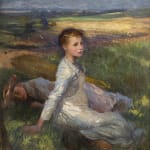-
Artworks
George Clausen 1852-1944
Summer in the Fields, late 1890sOil on canvasUnframed: 108 x 81.5 cm.; 42½ x 32 in.
Framed: 128 x 102 cm.; 50½ x 40 in.WB3206Copyright The ArtistClausen’s Summer in the Fields captures a perfect moment: two girls resting from haymaking in golden English sunlight. One sits alert, gazing across distant fields; her companion sleeps peacefully beside...Clausen’s Summer in the Fields captures a perfect moment: two girls resting from haymaking in golden English sunlight. One sits alert, gazing across distant fields; her companion sleeps peacefully beside her. This seemingly simple scene represents one of the outstanding achievements of British Impressionism.
Created in the late 1890s, the painting reveals Clausen transforming French influences into something unmistakably English. He drew the elevated perspective and figure arrangement from Jules Bastien-Lepage’s Les Foins (1878, Musée d’Orsay, Paris), which he had studied with great intensity. However, while the French masterpiece harboured undertones of rural poverty, Clausen’s vision feels uplifting, even romantic.
The composition draws us in through masterful spatial orchestration. Positioned high above the scene, we observe both intimate human drama and the expansive Essex countryside around Tilty and Clavering, near Clausen’s home. Our eyes naturally traverse from foreground figures across patchwork fields to the horizon, creating a seamless visual flow.
Clausen’s technical brilliance is evident throughout the canvas. The girl’s face is delicately modelled, capturing luminous flesh tones, while bold palette knife work in the sky creates clouds that appear to move. Small dabs of pure colour in the grass generate an optical shimmer, perfectly reflecting the essence of summer heat. Warm ochres and siennas contrast with cool violets and greens, while the seated girl’s face glows with an almost halo-like effect created by surrounding touches of mauve and emerald.
Summer in the Fields marks Clausen’s transition from literal naturalism to atmospheric experimentation. By painting specific English landscapes rather than generalised rural scenes, he helped to establish a tradition that celebrates native places and instils a sense of national pride. This was not just artistic innovation; it was cultural assertion. By the 1890s, British artists were tired of being seen as mere followers of French fashion. Clausen and his contemporaries were developing a distinctly British variant of modern painting that honoured international developments while celebrating native traditions and landscapes. Summer in the Fields is an exemplar and its exhibition at the Munich Secession is testament to the international recognition that British Impressionism had received by this period.
Provenance
The Artist's Studio sale
Christie's, London, 19 October, 1945, lot 136
Mitchell Galleries
Christie's, London, 10 November 1950, lot 100 (10gns. to Salz)
Private Collection
Christie's, London, 19 November 2004, lot 76
Private Collection
Exhibitions
Munich, Secession (catalogue untraced)
Join our mailing list
Be the first to hear about our upcoming exhibitions, events and news
* denotes required fields
We will process the personal data you have supplied to communicate with you in accordance with our Privacy Policy. You can unsubscribe or change your preferences at any time by clicking the link in our emails.




